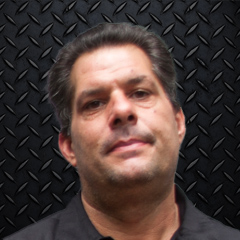
Harley Fender Repair
Bob LaRosaBob has the damaged area prepped on this Harley fender; ready for a short demonstration on applying filler.
It is important to correctly mix your filler. Mixing in too much harder will greatly reduce your work time. Make sure to spread plenty of filler over your Harley fender or part in question. Spreading too much filler is fine. It is much easier to remove filler than to add later. You want to avoid having to refill. This adds a lot more work and time to the repair.
Cutting, or removing filler can be accomplished with files (cheese graters), or with sandpaper on a flat block. Always sand, or file in different directions and watch for low spots. Choose the best grit sandpaper for your application. 36 grit paper is very aggressive but may be best when working a large area. Later, work over to 80 grit, and so on. Focus on feathering in your outer edge (where the repair ends and the undamaged area meet). This edge must be scrutinized over or will be noticeable when primer is applied.
Body work like this takes practice and patience. Be it a Harley fender, gas tank or other parts on the bench, it is not something that can be mastered over a weekend. It is of utmost importance that this type of work is done safely. Always utilize skin, ear, eye, and lung protection. Never begin mixing or sanding if you are not prepared to be protected.
